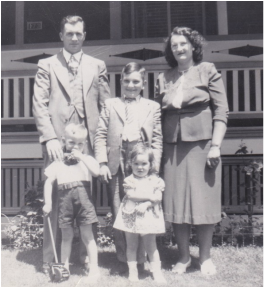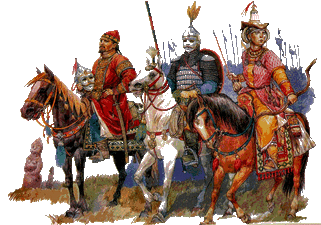|
That handsome man on the left was Bálint Daku, my maternal grandfather, with my grandmother, Julia Debreceni, and their 3 oldest children: Ben, Fred, and Eileen. My grandfather was born near Kipling, Saskatchewan, Canada, on the 20th of August, 1916, to Borbála Fonagy and Bálint Daku Sr. My grandfather was a Magyar, which is what Hungarians calls themselves. His parents migrated to Canada in 1904 as children and settled in the Hungarian colony of Bekevar, which means "fortress of peace". On the 1921 Canadian census, my great-grandfather reported his son's name as "Valentine", which is how Bálint translates to English. However, Bálint Sr. must have felt that this name was not sufficiently Canadian because from then on they were known as Ben. Since it's the tradition of Hungarian men to pass their name to their first sons, my grandfather named his first son Ben, who then named his first son Ben. My grandfather's own paternal grandfather was Károly Daku, who had moved his family to Canada from the town of Bezdéd in Austria-Hungarian Empire. Today, Tizabezdéd sits in the northeast corner of Hungary, very near to the Slovak and Ukraine borders. I know little of my Daku ancestry in Hungary. Károly's father was János Daku, who was also born in Bezdéd, and the family belonged to Hungarian Reformed Church, where I may be able to find baptismal records that trace the family a couple more generations. It's mostly guesswork to travel any further back in time but guesswork is fun! Daku is an Hungarian surname but it probably finds its roots much further east. In India, Daku is not only a surname but is a Hindi word that translates to "bandit". Are the Indian Daku and Hungarian Daku related? Maybe. In 1089, the Cumans ("Kunok" in Hungarian) invaded the Kingdom of Hungary. The Cumans were a loosely organized federation of fierce, warlike nomads who roamed an incredibly wide swath of central Asia and eastern Europe, from the Balkans to borders of Mongolia. Although their invasion was repelled by Hungary, the Cumans continued to be an influential power in eastern Europe, raiding and pillaging and hiring themselves out to the highest bidder as mercenaries. Although Turkish in culture, the Cumans were described as having reddish or blonde hair, fair skin, and blue eyes. I suspect these descriptions were relative to the black haired, darker skinned people that dominated the middle and far east, not that the Cumans resembled Scandinavians in appearance. Since their territory bridged east and west, the Cumans likely intermarried with both Asians and Europeans. In 1089, the Cumans ("Kunok" in Hungarian) invaded the Kingdom of Hungary. The Cumans were a loosely organized federation of fierce, warlike nomads who roamed an incredibly wide swath of central Asia and eastern Europe, from the Balkans to borders of Mongolia. Although their invasion was repelled by Hungary, the Cumans continued to be an influential power in eastern Europe, raiding and pillaging and hiring themselves out to the highest bidder as mercenaries. Although Turkish in culture, the Cumans were described as having reddish or blonde hair, fair skin, and blue eyes. I suspect these descriptions were relative to the black haired, darker skinned people that dominated the middle and far east, not that the Cumans resembled Scandinavians in appearance. Since their territory bridged east and west, the Cumans likely intermarried with both Asians and Europeans.
The Cuman language picked up many words from many different peoples along their range, including the word Daku, which exists in a few far-east languages. In the Cuman tongue, Daku means "a short furred coat", which was the garb of many nomads. When words cross from one language to another, sometimes the meaning changes. Could the Hindi word for "bandit" and the Cuman word for the garb often worn by a pillaging nomads be related? Of course, even if the Cumans and Indians did share this word, how did it make its way into Hungary? Crushed by the Mongol Golden Horde in 1239, many of the western Cuman tribes fled the steppe and sought refuge in Hungary. At first, the Hungarians and refugee Cumans allied together against the Mongols but, terrified by grim Mongol threats, the Hungarians betrayed their ally, slaying an influential khan. The enraged Cumans responded violently, ravaging the Hungarian countryside and fleeing to Bulgaria, leaving the weakened Hungarians on their knees before the Mongol Horde. After the Golden Horde departed the brutalized, depopulated Kingdom of Hungary, King Béla IV begged the Cumans to return, granting them lands and privileges. By the 15th century, the Cumans became fully settled into Hungary and, by the 19th century, most Cumans were almost fully absorbed into the population. So does that mean that the Daku paternal line reaches back to the Cumans? Yet again, it's possible, although we can really only guess. According to an Hungarian genetics study by István Raskó, 84% of Hungarians are of completely European ancestry, with only 16% having Asiatic markers. Of course, as we know, my mother and her brother, Ben, are among this 16%, with a trace of Mongolian and Yakut DNA, which the Cumans would have certainly carried. Of course, the best way to look at the distant past through genetics is to look to the yDNA. My grandfather's yDNA haplogroup is R1B-U152. This yDNA mutation occurred in a Celtic man about 3,500 years ago in the Alps of central Europe, possibly in the lands of modern day Switzerland or northern Italy. Some of the decedents of this man settled in the region while others migrated west, north, and south. Those that went south eventually became Romans while the others became the dominant people of northern and western Europe. It looks like very few migrated back to the east, where they faced much fiercer opposition from people on the Asiatic steppes. My first theory was that I had an Austrian 10th great grandfather, possibly a soldier sent to Hungary to suppress the rebellious Magyar. However, while R1B-U152 is rare in eastern Europe, it is very widely spread, meaning that is origins are much earlier than Austrian rule. Many believe that some Celts migrated back to eastern Europe over two thousand years ago, where they flourished for a time. During this time, they often clashed with a people known as the Scythians. Named by the Greeks, the Scythians were a nomadic people, born from the intermarriage of Siberians and Persians, that often clashed with the Celts in the Balkans. In eastern Hungary, including near Bezdéd, are many Scythian ruins. Of course, since R1B is rare in eastern Europe today, we know that the Celts did not prosper there for long but intermarriage with the Scythians may have spread the R1B-U152 haplogroup across eastern Europe and the near east. Neither the Cumans or Scythians were a single, unified people but loose federations of culturally similar tribes. The ancestors of many Cumans were undoubtedly people that the Greeks described as Scythians, who roamed much of the same range. Also, the Greeks described Scythians as having reddish hair, a trait many observers also attributed to the Cumans, which is possibly a blend between Asiatic and European features. As a final note, it's also possible that my maternal grandmother, Julia Debreceni, also traces her maternal line back to the Scythians. Her HV6a mtDNA haplogroup is relatively common among current day Iranians, which would have shared common ancestors with Scythians. Comments are closed.
|
Archives
2023 JAN FEB MAR APR MAY JUN JUL AUG SEP 2022 JAN FEB MAR APR MAY JUN JUL AUG SEP OCT NOV DEC 2021 JAN FEB MAR APR MAY JUN JUL AUG SEP OCT NOV DEC 2020 JAN FEB MAR APR MAY JUN JUL AUG SEP OCT NOV DEC 2019 JAN FEB MAR APR MAY JUN JUL AUG SEP OCT NOV DEC 2018 JAN FEB MAR APR MAY JUN JUL AUG SEP OCT NOV DEC 2017 JAN FEB MAR APR MAY JUN JUL AUG SEP OCT NOV DEC 2016 JAN FEB MAR APR MAY JUN JUL AUG SEP OCT NOV DEC 2015 JAN FEB MAR APR MAY JUN JUL AUG SEP OCT NOV DEC 2014 OCT NOV DEC Categories |


 RSS Feed
RSS Feed